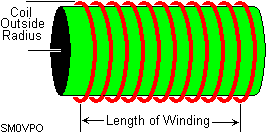

Here are a few calculators for electronic/radio circuits. They are quite crude, but they work. Note that these formulas now accept "floating point" variables (an inductance value of 0.01 is a valid number).

Just add them together!

Formula: Effective Resistance = (R1 x R2) / (R1 + R2)
(all units are the same, Ohms/Farads etc.)

Formula: Reactance = 1 / (2 * Pi * F * C)

Formula: Reactance = 2 * Pi * F * L

Formula: Frequency (F) = 1 / (2 * Pi * Sqrt(LC))

| Formula: |  |
 |

| Formula: |  |
 |

Calculates the effective temperature rise coefficient of a measured heatsink. Area is EXPOSED surface area of heatsink in square centimeters.
| Formula: | Degrees Centigrade per Watt = 50 / Sqrt(Area sq-cm ) |

Calculates heatsink surface area needed for a given heatsink temperature coefficient.
| Formula: | Area Required (sq-cm) = Sq (50/C-watt) |


| Formulas: |  |
The Input/Output powers may be in any electrical unit you prefer, eg: Meggawatts, Picowatts, Joules, Hamster-treadmill revolutions per hour etc.
Negative values of resistance occur when impossible values of input and output impedance and attenuation are entered. For example, it is not possible to drive a 50-ohm line from a 600-ohm line and have a voltage attenuation factor of less than 6.78


| Formulas: |  |
The Input/Output powers may be in any electrical unit you prefer, eg: Meggawatts, Picowatts, Joules, Hamster-treadmill revolutions per hour, etc.
Again, negative values indicate an impossible attenuation situation.

I will now research formulas for the calculation of alcoholic strength/sugar quantity for brewing as well as for calculating alcoholic content of the "mash" when the boiling temperature is known. If you have any information in these fields, or you think another aspect of radio/electronis would be usefull then please drop me a line. Very best regards from Harry - SM0VPO
